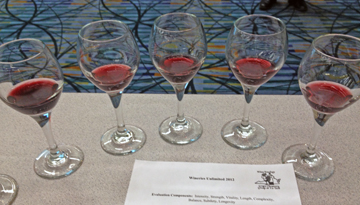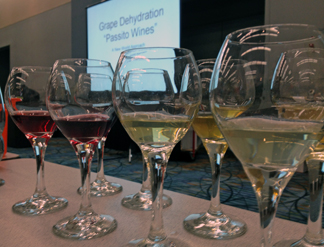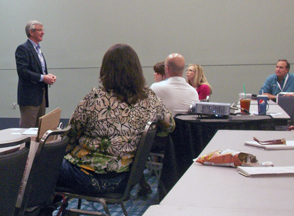Wineries Unlimited 2012 Day 3 Overview
by
Terry and Kathy Sullivan
There were several enological sessions on Thursday, four of them had wine flights that matched the content of the session. There we additional marketing sessions at the same time.
Bruce Zoecklein: Practical Monitoring and Management of Brettanomyces
Bruce discussed the misconceptions about brett. He mentioned that some brett descriptors can be positive such as complex, mature and spicy. Some people even like negative descriptors, wet dog for example. Brett is like a yeast, having many different strains. Wine in the bottle may develop high levels of brett at different times, even years after bottling. The best way to monitor brett is sensory analysis. Some wine could have a high concentration of brett metabolites and you can’t smell it. Similarly a wine could have a small concentration of brett metabolites and smell very much like brett. Bruce cautions that if one uses wine additives, understand what they will and can do to the wine. It comes down to diligence and monitoring.
Charlotte Gouraud: Using Non-Saccharomyces Yeast During Alcoholic Fermentation: Taking Advantage of Yeast Biodiversity
Charlotte spoke of research that has been done on non-saccharomyces yeasts. Photos showed shape and size of a saccharomyces yeast compared to torulaspora delbrueckii yeast. A graph showed that there is generally a lower volatile acidity associated with torulaspora yeast compared to saccharomyces yeast. Torulaspora yeasts will do better in cooler fermentations. Charlotte suggested that winemakers may want to begin the fermentation with torulaspora and after a few days (24 hours in red wines, 72 hours in white wines) add saccharomyces. With the use of torulaspora there can be an increase in aromatic aromas and phenolics while a decrease in vegetal characteristics.
Dr. Nichola Hall: Influence of yYeast Strain Choice on the success of Malolactic Fermentation
Microbial populations effect on the wine don’t stop when the wine is bottled. Dr. Nichola Hall pointed out that Saccharomyces is the yeast strains of choice for winemakers. It needs to be malolactic fermentation friendly. There are many strains of Oenococcus oeni available for winemakers to choose from. Between the Saccharomyces cerevisiae yeast strain and the Oenococcus oeni bacteria strain there are 5400 combinations. Winemakers should select a strain that fits the parameters the winemaker is using such as alcohol level and temperature.
 Sigrid Gertsen-Schibbye: Malolactic Trials - The proof is in the Tasting
Sigrid Gertsen-Schibbye: Malolactic Trials - The proof is in the Tasting
The setting for this session included a tasting of 5 red wines. Sigrid mentioned that it was nice to have a tasting of different MLF inoculations first as opposed to last. The wine used was a Merlot that was the same in each glass except for the MLF.
The Merlot that had no MLF was a darker ruby color and those that were co-inoculated were a lighter ruby color. All offered slight aromas and dark fruit tastes. There seemed to be more of a hint of earthiness on the Merlot that had no MLF. The attendees were mixed on ther preferences. Some like the wine with no MLF, others like the wine that was co-inoculated while other liked the sequentially inoculated. One of the themes of the conference was for attendees to sift through the information and determine what fits their needs.
Charlotte Gouraud: Wine Tasting of Yeast Trials
The second tasting had four white wines that looked at yeasts. The wines were from King Family Vineyards, Virginia. The first two wines were Viognier and the 3rd and 4th winers were Chardonnay. Wines 1 and 3 were the control wines with a saccharomyces yeast added. Wines 2 and 4 were the alpha wines with a torulaspora yeast added first followed by a saccharomyces yeast eight days later. The most notable difference was the softer mouthfeel with the wines that were first started with torulaspora yeast.
 Michael Shaps: Grape Dehydration “Passito Wines”
Michael Shaps: Grape Dehydration “Passito Wines”
Michael spoke of drying grapes on dry racks. Now he is experiencing with dry racks in old tobacco barns. Dehydration concentrates sugars and flavors. The Virginia method, that seems to be developing, is to leave the grapes in in lugs 2/3 full. The lugs are placed in a tobacco barn evenly distributed. One can’t use any fruit. The grapes need to be clean with no rot, skins need to be in good condition and grapes must have achieved reasonable maturity.
Wines were tasted in pairs. All were from barrel. The first of each pair was made with non-dried fruit while the second in each pair was made with dried fruit. In all cases wines made with the dried fruit were darker in color. Many of the dried fruit wines had some jammy fruit and dried fruit characters. As in an earlier wine tasting, many of the session attendees were divided in their preferences.
Shap Rouse: Cryoextraction Techniques for Sweet Wine Production
Shap defined cryoextraction as picking the grapes when they are clean and freezing them. Press the grape when they are partially frozen and make wine. Shap commented that Virginia’s climate is not conducive to making a late harvest wine. He likes the cryoextraction process because he isn’t dependent on a calendar or frozen weather to harvest the grapes. Shap did comment negatively on those northern winemakers that make Icewine. The winemaker sitting next to me was from Vermont and commented that one would hear a different view on the topic from winemakers in the North.
Two wines were tasted both of which went through the cryoextraction process. Both wines were blends of Vidal Blanc, Vignoles, Riesling and Traminatte. One wine was crafted with 2008 fruit and the other with 2009 fruit. Both wines were sweet and offered a crisp finish. The aromas and tastes were floral with dried fruit. The cryoextraction method is certainly one way to make a dessert wine especially in wine regions that can’t make Icewines.
Paul Wagner: How to Sell Wine and How You Can Tell if You’re Doing it Right
Paul presented two scenarios. The first was the “Home Game” and Wagner described how to create sales in the winery tasting room. Wagner noted that anything can be sold to anyone at the right time.
He detailed how to greet customers to a winery suggesting that each visitor should be greeted within 10 seconds. Then he suggested questions to ask that would make the customer comfortable and create a rapport. Attention should be focused on the customer and a rapport achieved. Questions to ask include: How are you? Where are you from? Would you like to taste some wines? Eventually the questions become focused on encouraging a wine taster to purchase wine.
 During his presentation Wagner noted that millennials do not want to know about the wine, they want the stories that they can take home with them and share with others. Many others would enjoy the stories. He also indicated that winery owners should not look at their winery visitors in the same way grocery stores look at customers. Create an emotional connection. For example, call a visitor who purchases your wine and ask them how they like the wine. This will indicate that you are thoughtful and generous thus making another connection with the customer.
During his presentation Wagner noted that millennials do not want to know about the wine, they want the stories that they can take home with them and share with others. Many others would enjoy the stories. He also indicated that winery owners should not look at their winery visitors in the same way grocery stores look at customers. Create an emotional connection. For example, call a visitor who purchases your wine and ask them how they like the wine. This will indicate that you are thoughtful and generous thus making another connection with the customer.
The above scenario seemed to be based on one on one leading to a question of how to deal with numerous people in the tasting room. Paul noted that when that is the case work with people in groups. Paul’s response included that one should not walk away from his group to ring up a $20 sale.
Wagner discussed what he called the “Away Game.” This is selling wine outside of the winery to businesses. Start by making sure it’s a good time for them to talk about your wines. If it is not a good time, leave and return at a later date. Let the owner know you will help them sell your wines.
Wagner’s presentation ended with “How do we measure success?” Wagner stressed not to just count the number of cases sold but also look at the number of meetings held, the number of appointments made and the number of repeat business. Paul Wagner has the knowledge and experience to help wineries sell their wine.
The last day of the conference was filled with content. The wine tastings associated with the enology sessions were excellent and the marketing sessions gave wineries information for them to consider.
